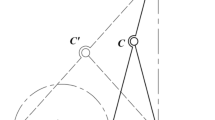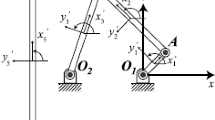Abstract
Bio-inspired mechanism not only needs to be able to reproduce the movement laws of creature, but also has its shape. In order to simplify the design process and improve the design efficiency of one-degree-of-freedom (DOF) bio-inspired mechanism (especially six-bar or eight-bar mechanism), a design method based on layered constraint conditions is proposed in this paper. On the basis of the one-DOF kinematic chain, the frame is selected and the links are added in turn. At the same time, the constraint conditions are given in layers in the form of inequalities. When a closed loop is formed, the kinematic model needs to be established, and the positions of the target points or the attitudes of the target links can be represented by the driving angles or given angles. Thus, the feasible configurations and the ranges of the link lengths can be obtained. By cycling the above process, the target points can approach the reference points quickly and the design efficiency of the mechanism can be improved. The effect of the different basic kinematic chain, closed-loop forms and constraint conditions on configurations and design efficiency is analyzed in detail. It provides a reference for the design of other one-DOF mechanisms with multiple constraint conditions.


















Similar content being viewed by others
Availability of data and material
All data and material in this paper are transparent and available.
Code availability
The custom codes covered in this paper are available.
References
Bai L, Zheng F, Chen X et al (2018) Design and experimental evaluation of a single-actuator continuous hopping robot using the geared symmetric multi-bar mechanism. Appl Sci 9:9010013
Bai SP, Wang DL, Dong HM (2016) A unified formulation for dimensional synthesis of Stephenson linkages. J Mech Robot 8(4):041009
Baser O, Kizilhan H, Kilic E (2019) Biomimetic compliant lower limb exoskeleton (BioComEx) and its experimental evaluation. J Braz Soc Mech Sci 41(5):226
Eqra N, Abiri AH, Vatankhah R (2018) Optimal synthesis of a four-bar linkage for path generation using adaptive PSO. J Braz Soc Mech Sci 40(9):469
Eqra N, Taghvaei Vatankhah R (2019) Optimal kinematic design of a single-DOF planar grasper based on metaheuristic optimization. J Braz Soc Mech Sci 41(10):410
Funke LW, Schmiedeler JP (2017) Simultaneous topological and dimensional synthesis of planar morphing mechanisms. J Mech Robot 9(2):021009
Haldane DW, Plecnik M, Yim JK (2016) Robotic vertical jumping agility via series-elastic power modulation. 1(1):eaag2048
Han J, Qian W (2009) On the solution of region-based planar four-bar motion generation. Mech Mach Theory 44(2):457–465
Han J, Yang T, Yu J (2015) Advanced mechanisms. Machinery Industry Press, Beijing
Han J, Yang T (2012) A novel synthesis method for three-position motion generation with planar four-bar mechanisms. In: ASME 2012 international design engineering technical conferences and computers and information in engineering conference. ASME, pp 419–426
Kim HG, Lee DG, Jeong KM (2016) Water and ground-running robotic platform by repeated motion of six spherical footpads. IEEE-ASME Trans Mech 21(1):175–183
Kim HG, Seo M, Sitti TW (2017) Tail-assisted mobility and stability enhancement in yaw/pitch motions of a water-running robot. IEEE-ASME Trans Mech 22(3):1207–1217
Kiper G (2015) Motion synthesis of a planar Watt II type six-bar mechanism with two end-effectors. In: 3rd conference of the mechanisms transmissions and applications. Springer, pp 89–97
Li F, Liu W, Fu X (2012) Jumping like an insect: design and dynamic optimization of a jumping mini robot based on bio-mimetic inspiration. Mechatronics 22(2):167–176
Li X, Zhao P, Ge QJ et al (2013) A task driven approach to simultaneous type synthesis and dimensional optimization of planar parallel manipulator using algebraic fitting of a family of quadrics. In: ASME 2013 international design engineering technical conferences and computers and information in engineering conference. ASME, pp 1–6
Mouton LLN, Flemming AF, Kanga EM (1999) Grouping behaviour, tail-biting behaviour and sexual dimorphism in the armadillo lizard (Cordylus cataphractus) from South Africa. J Zool 249:1–10
Oliva JC, Goodman ED (2009) Evolutionary search and convertible agents for the simultaneous type and dimensional synthesis of planar mechanisms. In: Genetic and evolutionary computation conference. SIGEVO
Park Y, Huh TM, Park D et al (2014) Design of a variable-stiffness flapping mechanism for maximizing the thrust of a bio-inspired underwater robot. Bioinspir Biomim 9(3):036002
Plecnik MM, McCarthy JM (2016) Computational design of Stephenson II six-bar function generators for 11 accuracy points. J Mech Robot 8(1):011017
Plecnik MM, McCarthy JM (2016) Design of Stephenson linkages that guide a point along a specified trajectory. Mech Mach Theory 96:38–51
Plecnik MM, Mccarthy JM (2016) Kinematic synthesis of Stephenson III six-bar function generators. Mech Mach Theory 97:112–126
Rajestari Z, Feizi N, Taghvaei S et al (2017) Optimal kinematic synthesis and fabrication of a one-DoF prosthetic finger. J Braz Soc Mech Sci 39(8):2925–2934
Shen ZF, Allison G, Cui L (2018) An integrated type and dimensional synthesis method to design one degree-of-freedom planar linkages with only revolute joints for exoskeletons. J Mech Des 140(9):092302
Singh R, Chaudhary H, Singh AK (2019) A loop-by-loop defect rectification procedure for optimal synthesis of Stephenson III path generators. Meccanica 54(11–12):1869–1888
Suzuki K, Ichinose RW, Takanobu H (2017) Development of water surface mobile robot inspired by water striders. Micro Nano Lett 12(8):575–579
Suzuki K, Takanobu H, Noya K (2007) Water strider robots with microfabricated hydrophobic legs. In: International conference on intelligent robots and systems. IEEE, pp 590–595
Wang G, Chen D, Chen K et al (2015) The current research status and development strategy on biomimetic robot. J Mech Eng 51(13):27–44
Wolbrecht ET, Reinkensmeyer DJ, Perez-Gracia A (2011) Single degree-of-freedom exoskeleton mechanism design for finger rehabilitation. In: International conference on rehabilitation robotics (ICORR). IEEE
Yang T, Han J, Yin L (2011) A unified synthesis method based on solution regions for four finitely separated and mixed “Point-Order” positions. Mech Mach Theory 46(11):1719–1731
Zhang Y, Zhao J, Chen W et al (2019) Biomimetic skeleton structure of morphing nose cone for aerospace vehicle inspired by variable geometry mechanism of honeybee abdomen. Aerosp Sci Technol 92:405–416
Zhang Z, Chen D, Chen K (2016) Analysis and comparison of two jumping leg models for bioinspired locust robot. J Bionic Eng 13(4):558–571
Zhang ZQ, Yang Q, Gui S et al (2019) Mechanism design for locust-inspired robot with one-DOF leg based on jumping stability. Mech Mach Theory 133:584–605
Zhang Z, Yang Q, Zhao J et al (2020) Kinematic synthesis method for the one-degree-of-freedom jumping leg mechanism of a locust-inspired robot. Sci China Technol Sc 63(3):472–487
Zhao J, Yan S, Deng L et al (2017) Design and analysis of biomimetic nose cone for morphing of aerospace vehicle. J Bionic Eng 14(2):317–326
Zhao P, Li XY, Purwar A et al (2016) A task-driven unified synthesis of planar four-bar and six-bar linkages with R- and P-joints for five-position realization. J Mech Robot 8(6):061003
Funding
This work was supported by the National Natural Science Foundation of China (Grant No. 51805010), General Project of Beijing Education Commission (Grant No. KM201910005032), China Postdoctoral Science Foundation funded project (Grant No. 2019T120030) and National Key Research and Development Program of China (Grant No. 2018YFB1304602).
Author information
Authors and Affiliations
Contributions
ZZ proposed the mechanism design method and wrote the full text. JL completed part of the theoretical analysis. JZ guided the theoretical analysis process and made useful suggestions. XL modified the content of the article. HL was involved in the writing of the program.
Corresponding author
Additional information
Technical Editor: Adriano Almeida Gonçalves Siqueira.
Publisher's Note
Springer Nature remains neutral with regard to jurisdictional claims in published maps and institutional affiliations.
Electronic Supplementary Material
Below is the link to the electronic supplementary material.
Rights and permissions
About this article
Cite this article
Zhang, Z., Liao, J., Zhao, J. et al. Design method of one-DOF bio-inspired mechanism based on layered constraint conditions. J Braz. Soc. Mech. Sci. Eng. 42, 454 (2020). https://doi.org/10.1007/s40430-020-02542-9
Received:
Accepted:
Published:
DOI: https://doi.org/10.1007/s40430-020-02542-9




